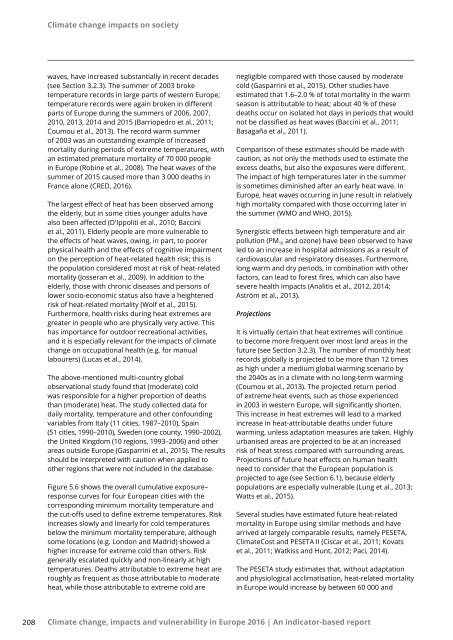Climate change impacts and vulnerability in Europe 2016
document
document
You also want an ePaper? Increase the reach of your titles
YUMPU automatically turns print PDFs into web optimized ePapers that Google loves.
<strong>Climate</strong> <strong>change</strong> <strong>impacts</strong> on society<br />
waves, have <strong>in</strong>creased substantially <strong>in</strong> recent decades<br />
(see Section 3.2.3). The summer of 2003 broke<br />
temperature records <strong>in</strong> large parts of western <strong>Europe</strong>;<br />
temperature records were aga<strong>in</strong> broken <strong>in</strong> different<br />
parts of <strong>Europe</strong> dur<strong>in</strong>g the summers of 2006, 2007,<br />
2010, 2013, 2014 <strong>and</strong> 2015 (Barriopedro et al., 2011;<br />
Coumou et al., 2013). The record warm summer<br />
of 2003 was an outst<strong>and</strong><strong>in</strong>g example of <strong>in</strong>creased<br />
mortality dur<strong>in</strong>g periods of extreme temperatures, with<br />
an estimated premature mortality of 70 000 people<br />
<strong>in</strong> <strong>Europe</strong> (Rob<strong>in</strong>e et al., 2008). The heat waves of the<br />
summer of 2015 caused more than 3 000 deaths <strong>in</strong><br />
France alone (CRED, <strong>2016</strong>).<br />
The largest effect of heat has been observed among<br />
the elderly, but <strong>in</strong> some cities younger adults have<br />
also been affected (D'Ippoliti et al., 2010; Bacc<strong>in</strong>i<br />
et al., 2011). Elderly people are more vulnerable to<br />
the effects of heat waves, ow<strong>in</strong>g, <strong>in</strong> part, to poorer<br />
physical health <strong>and</strong> the effects of cognitive impairment<br />
on the perception of heat‐related health risk; this is<br />
the population considered most at risk of heat‐related<br />
mortality (Josseran et al., 2009). In addition to the<br />
elderly, those with chronic diseases <strong>and</strong> persons of<br />
lower socio‐economic status also have a heightened<br />
risk of heat‐related mortality (Wolf et al., 2015).<br />
Furthermore, health risks dur<strong>in</strong>g heat extremes are<br />
greater <strong>in</strong> people who are physically very active. This<br />
has importance for outdoor recreational activities,<br />
<strong>and</strong> it is especially relevant for the <strong>impacts</strong> of climate<br />
<strong>change</strong> on occupational health (e.g. for manual<br />
labourers) (Lucas et al., 2014).<br />
The above‐mentioned multi‐country global<br />
observational study found that (moderate) cold<br />
was responsible for a higher proportion of deaths<br />
than (moderate) heat. The study collected data for<br />
daily mortality, temperature <strong>and</strong> other confound<strong>in</strong>g<br />
variables from Italy (11 cities, 1987–2010), Spa<strong>in</strong><br />
(51 cities, 1990–2010), Sweden (one county, 1990–2002),<br />
the United K<strong>in</strong>gdom (10 regions, 1993–2006) <strong>and</strong> other<br />
areas outside <strong>Europe</strong> (Gasparr<strong>in</strong>i et al., 2015). The results<br />
should be <strong>in</strong>terpreted with caution when applied to<br />
other regions that were not <strong>in</strong>cluded <strong>in</strong> the database.<br />
Figure 5.6 shows the overall cumulative exposure–<br />
response curves for four <strong>Europe</strong>an cities with the<br />
correspond<strong>in</strong>g m<strong>in</strong>imum mortality temperature <strong>and</strong><br />
the cut‐offs used to def<strong>in</strong>e extreme temperatures. Risk<br />
<strong>in</strong>creases slowly <strong>and</strong> l<strong>in</strong>early for cold temperatures<br />
below the m<strong>in</strong>imum mortality temperature, although<br />
some locations (e.g. London <strong>and</strong> Madrid) showed a<br />
higher <strong>in</strong>crease for extreme cold than others. Risk<br />
generally escalated quickly <strong>and</strong> non-l<strong>in</strong>early at high<br />
temperatures. Deaths attributable to extreme heat are<br />
roughly as frequent as those attributable to moderate<br />
heat, while those attributable to extreme cold are<br />
negligible compared with those caused by moderate<br />
cold (Gasparr<strong>in</strong>i et al., 2015). Other studies have<br />
estimated that 1.6–2.0 % of total mortality <strong>in</strong> the warm<br />
season is attributable to heat; about 40 % of these<br />
deaths occur on isolated hot days <strong>in</strong> periods that would<br />
not be classified as heat waves (Bacc<strong>in</strong>i et al., 2011;<br />
Basagaña et al., 2011).<br />
Comparison of these estimates should be made with<br />
caution, as not only the methods used to estimate the<br />
excess deaths, but also the exposures were different.<br />
The impact of high temperatures later <strong>in</strong> the summer<br />
is sometimes dim<strong>in</strong>ished after an early heat wave. In<br />
<strong>Europe</strong>, heat waves occurr<strong>in</strong>g <strong>in</strong> June result <strong>in</strong> relatively<br />
high mortality compared with those occurr<strong>in</strong>g later <strong>in</strong><br />
the summer (WMO <strong>and</strong> WHO, 2015).<br />
Synergistic effects between high temperature <strong>and</strong> air<br />
pollution (PM 10 <strong>and</strong> ozone) have been observed to have<br />
led to an <strong>in</strong>crease <strong>in</strong> hospital admissions as a result of<br />
cardiovascular <strong>and</strong> respiratory diseases. Furthermore,<br />
long warm <strong>and</strong> dry periods, <strong>in</strong> comb<strong>in</strong>ation with other<br />
factors, can lead to forest fires, which can also have<br />
severe health <strong>impacts</strong> (Analitis et al., 2012, 2014;<br />
Aström et al., 2013).<br />
Projections<br />
It is virtually certa<strong>in</strong> that heat extremes will cont<strong>in</strong>ue<br />
to become more frequent over most l<strong>and</strong> areas <strong>in</strong> the<br />
future (see Section 3.2.3). The number of monthly heat<br />
records globally is projected to be more than 12 times<br />
as high under a medium global warm<strong>in</strong>g scenario by<br />
the 2040s as <strong>in</strong> a climate with no long-term warm<strong>in</strong>g<br />
(Coumou et al., 2013). The projected return period<br />
of extreme heat events, such as those experienced<br />
<strong>in</strong> 2003 <strong>in</strong> western <strong>Europe</strong>, will significantly shorten.<br />
This <strong>in</strong>crease <strong>in</strong> heat extremes will lead to a marked<br />
<strong>in</strong>crease <strong>in</strong> heat-attributable deaths under future<br />
warm<strong>in</strong>g, unless adaptation measures are taken. Highly<br />
urbanised areas are projected to be at an <strong>in</strong>creased<br />
risk of heat stress compared with surround<strong>in</strong>g areas.<br />
Projections of future heat effects on human health<br />
need to consider that the <strong>Europe</strong>an population is<br />
projected to age (see Section 6.1), because elderly<br />
populations are especially vulnerable (Lung et al., 2013;<br />
Watts et al., 2015).<br />
Several studies have estimated future heat-related<br />
mortality <strong>in</strong> <strong>Europe</strong> us<strong>in</strong>g similar methods <strong>and</strong> have<br />
arrived at largely comparable results, namely PESETA,<br />
<strong>Climate</strong>Cost <strong>and</strong> PESETA II (Ciscar et al., 2011; Kovats<br />
et al., 2011; Watkiss <strong>and</strong> Hunt, 2012; Paci, 2014).<br />
The PESETA study estimates that, without adaptation<br />
<strong>and</strong> physiological acclimatisation, heat-related mortality<br />
<strong>in</strong> <strong>Europe</strong> would <strong>in</strong>crease by between 60 000 <strong>and</strong><br />
208 <strong>Climate</strong> <strong>change</strong>, <strong>impacts</strong> <strong>and</strong> <strong>vulnerability</strong> <strong>in</strong> <strong>Europe</strong> <strong>2016</strong> | An <strong>in</strong>dicator-based report


